HERITAGE LIVING
South Australian Tree of the Year



200 years of glamourous gowns

Saturday 15 May • Ayers House Museum Join
See pages 18-19.
With the easing of Covid-19 restrictions, life is returning to a new normal at many of our places and visitor numbers are particularly strong in regional areas.
We marked the New Year with the completion of major restoration works on our newest property, the North Adelaide Baptist Church. In celebration, we staged our first music performance within the church, with the amazing Artaria presenting a stunning program that showcased the brilliant acoustic of the space to the delight of a sell-out crowd. We have now also resumed weekly lunchtime concerts in the church hall, presented in conjunction with Recitals Australia.
New events at Stangate House in the Adelaide Hills, including monthly open gardens and a special Valentine’s Day picnic celebration, have introduced this magnificent garden to many first-time visitors. Collingrove in the Barossa Valley hosted its second wellness weekend retreat in February and will host further music events including a special Mother’s Day performance.
Widespread community outrage over plans to demolish the former Waite Gatehouse lodge at Urrbrae finally led to a backdown from the State Government after more than 1,000 people rallied to prevent its demolition and to force a rethink by the transport department. Thank you to those who supported the cause and reminded the government of its responsibilities to protect our heritage.
Regrettably, in March the State Government proceeded to implement its new Planning and Design Code, which will impact everyone, without genuine public consultation on its provisions. The lax regulation of development and the weakening of existing heritage protections under the code threaten further losses of historic buildings, trees and open space to make way for high density development, as well as removing community rights to know about or to appeal proposed developments.
The consequences will be felt for decades to come as our urban environment loses more of its historic character, trees and greenspace and the community loses its voice in planning policy and development decisions. The Trust will continue to campaign for better heritage and tree protections, and for restoration of community and landholder rights in planning and development decisions.
May brings South Australia’s History Festival, with events across the State that encourage people to get out and explore our history and heritage. Our Pioneer Women’s Trail Walk from Hahndorf to Beaumont is an annual highlight, but you can find dozens more events in the What’s On section of this issue. We look forward to seeing you out and about enjoying our heritage!
4 HERITAGE AT RISK
Saving the Gatehouse
The battle to save Urrbrae gatehouse lodge

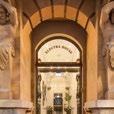
6 TREES South Australia’s 2021 Tree of the Year Help save our trees

8 URBAN
9 HERITAGE AT RISK
10 HERITAGE TOURISM
12 AUSTRALIAN ARTISAN TRADES ACADEMY Capturing a heritage painting masterclass
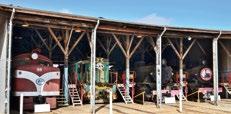
Following a vigorous public campaign, the former Waite gatehouse lodge at Urrbrae has been saved from demolition to make way for an intersectionwidening project by the Department for Infrastructure and Transport. On 31 January, more than 1,000 people gathered on site to demand that the building be saved. During the protest, the following address was given by George Morgan, greatgreat-grandson of Peter Waite, who gifted the Urrbrae property to the people of South Australia.

My name is George Morgan, and I speak on behalf of the 53 living relatives of pastoralist and State benefactor, Peter Waite. I wish to pose a question on behalf of these descendants. Who are these people who wish to annex this land and raze the State heritage-listed Gatehouse Lodge, an integral part of my great-great-grandfather Peter Waite’s legacy to South Australia?
Throughout my life I have driven past the Waite Institute. As children we were reminded that our ancestor’s bequest had created this agricultural research station. We have all visited the Urrbrae House museum many times, and are proud of the achievements and legacy of Peter and Matilda Waite.
Who are these people that would ransack this legacy? Did they, too, not wonder what is this place as they were driven past the tilled fields and swaying crops, here deep in suburbia? In addition to the bequest of land and money for the research institute, there was the establishment of the arboretum, a marvellous library of trees, aimed at assessing their viability in
South Australian conditions, and as an ongoing botanical resource.
Who are these people who fail to recognise the intrinsic value of public gardens, parks and trees? For us, a plant is a source of constant satisfaction and a public park a site where imagination can take flight and soar. Who are these people and how did they learn to see a park as nothing at all, if not something to be sold, privatised and covered in bitumen and cement?
Peter Waite believed in future prosperity being driven by science, and the technologies that spun out of research. He recognised that feeding the world was a worthy ambition, and he wanted to be instrumental in an improved and abundant food production utilising the experimental crop facility in the research institute.
He loved new adaptive technologies. In the early 1900s he installed the first refrigeration unit in the State, and his daughters drove an electric car powered by batteries made of iron. Who are these people whose vision for the future goes only so far as to lay
down bitumen so that traffic may wait ten seconds less? Are there not more imaginative solutions at hand in this modern world?
The Waite Research Institute clearly had an educational role, just as has the Urrbrae High School, which was created on land and with funding from the Waite bequest. For Peter Waite, the education of women was important and, with others, he was instrumental in creating Seymour College so that girls from city and country could enjoy and value opportunities for a good education.
Peter Waite had a vision spawned by post-reformation European enlightenment and contributing to the future of the State, its people and the nation. A vision of education as a priority, of scientific endeavour for the betterment of humanity, and of parks and open space for public amenity, curiosity and pleasure.
This is a vision, not based on last week’s election speech, not on yesterday’s press release spun by media dissemblers, but on action, generosity and a gift to the State over 100 years ago. This vision is what
created the South Australia where people aspire to live and thrive. A hopeful and creative vision that created the economic, political and cultural world we enjoy today. The citizens of South Australia are all the descendants of Peter Waite’s legacy.
But, again, who are these people who would despoil this legacy? They are our elected representatives and their bureaucratic machines. Have they forgotten, or did not realise, that they too are the custodians and beneficiaries of Peter Waite’s vision? To demolish the Waite Gatehouse, to annex land from the park and the school, is an act of vandalism that defiles the very best and most admirable of South Australia’s history. Who are these people who seek to do this?
It was not until early this year that the public became fully aware of the threat to the state heritage-listed gatehouse lodge at Urrbrae posed by the State Government’s decision to massively and unnecessarily widen the Cross and Fullarton roads intersection. The 130-year-old gatehouse was simply collateral damage in the government’s plans to appropriate land bequeathed to the University of Adelaide by pastoralist Peter Waite and now forming part of the Waite Arboretum.
The people of South Australia have delivered a resounding verdict, forcing the government to change both the plan and, hopefully, its thinking about treating our heritage with disdain.
The campaign to save and relocate the gatehouse was met with misinformation and stubbornness from the Minister for Infrastructure and Transport Corey Wingard. He maintained that 70 trees would have to be sacrificed if the gatehouse were to be was relocated. This was incorrect. The only trees at risk are those in the way of the intersection widening. Then, in attempting to abrogate responsibility for the fate of the gatehouse, Minister Wingard moved to broker financial arrangements with the university, which were cynical and unworkable. His offer of $2 million from a heritage fund, thereby depriving other worthwhile projects of support, was a blatant attempt to wedge the university if it, quite reasonably, refused the offer.
The government also offered $2 million in land acquisition compensation for use in relocation, being well aware that a university statute prevented the use of this money for anything other than teaching and research. And, in a final threatening move, the government signalled its intent to apply to the State Commission Assessment Panel (SCAP) for permission to demolish the gatehouse if the university failed to take steps to move it.
By the time the government capitulated and agreed to save the gatehouse, the campaign had recruited 18,000 signatures on an on-line petition, 8,000 on a paper petition, and more than 1,000 people at the second of two community rallies.
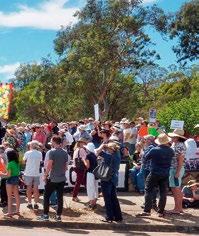
The government has offered to avoid demolition by ‘deconstructing and reconstructing’ the gatehouse. However, the preferred safer and cheaper alternative would have been to relocate the whole building.
It is likely that the government will wish to expedite the gatehouse deconstruction (dismantling) to allow the intersection project to meet its deadlines. The risk, then, is that the materials will lie fallow, and there will be no imperative or urgency to efficiently and safely relocate and reconstruct this precious building.
Concerned community and heritage advocates will monitor these developments closely. It is vital that the gatehouse is reconstructed accurately, creating like for like, using the original materials and retaining its State Heritage status. Anything less will be met with a new and vigorous public campaign.
ABOVE:
Above: Part of the huge crowd that gathered at Urrbrae in January to protest demolition of the gatehouse lodge (photo by Ron Bellchambers). * This Opinion piece by Protect our Heritage Alliance convenor Professor Warren Jones AO was originally published by Indaily on 8 April 2021. convenor@protectourheritage.org.auA spectacular example of the rare Dingley Dell Gum (featured on our front cover) has been voted the winner of the inaugural South Australian Tree of the Year competition.
The competition was initiated by Tom Morrison, who was named the 2021 City of Mitcham’s Young Citizen of the Year for his efforts to raise awareness about the importance of protecting our native and significant trees. Tom started the popular Facebook page, 20 Metre Trees, where he advocates for the value of large trees, particularly in urban environments.
As part of the South Australian Tree of the Year competition, the public was encouraged to nominate their favourite trees for recognition, by taking images of them and giving a brief description of why they thought the tree should be awarded the title.
Many different species of different sizes were nominated from across a wide area and for a variety of reasons, creating a showcase for some of the State’s most impressive trees. Encouragingly, many entries came from their nominators’ own backyards, with people sharing personal stories about their connections to the trees and the benefits they gave them.
Once nominations closed, a short-list of 24 trees was selected by an expert panel of judges from the National Trust, Trees for Life and the Conservation Council. This short-list was then made available for a public vote.
The 2021 winner is an example of Eucalyptus leucoxylon ssp.
megalocarpa, known in the Port MacDonnell area as the Dingley Dell gum because it grows around Dingley Dell cottage. During the 1860s, the historic house was home to famous Australian poet, Adam Lindsay Gordon, who reportedly wrote poetry sitting in the boughs of one of them.

Also commonly known as a large-fruited blue gum in South Australia, and a large-fruited yellow gum in Victoria, the sub species is found mainly in a narrow coastal strip stretching from the Lower South East of the State across to the Glenelg River, just over the Victorian border. A highly ornamental and hardy tree, which attracts nectar-eating birds and insects, its wood was traditionally used by indigenous peoples to make fighting sticks and shields.
One of the largest remaining stands in the State is in Germain Reserve at Port MacDonnell, where they have survived a tough environment, with strong coastal winds and shallow saline soils. The tree can even be found growing prostrate along wind-torn cliff tops.
The winning tree’s nominator put it forward because it represents South Australia’s southern-most gum and there are few mature examples left due to clearing for agriculture. “She's twisted and beautiful, especially in the mottled light of a setting sun!"
If you are visiting Port MacDonnell, or Dingley Dell cottage, please go and pay your respects fo a worthy competition winner.
 PICTURED:
Above and below: Above: The ‘twisted and beautiful’ Dingley Dell gum, which was named 2021 South Australian Tree of the Year.
PICTURED:
Above and below: Above: The ‘twisted and beautiful’ Dingley Dell gum, which was named 2021 South Australian Tree of the Year.
A new public campaign is setting out to save our trees, and demand stronger action from the State Government to address the staggering losses occurring across South Australia, particularly in urban areas.
Trees are a vital part of the urban environment. They provide a cooling effect by offering shade and lowering temperatures, as well as storing carbon, improving soil and water conservation and supporting greater biodiversity and human well-being.
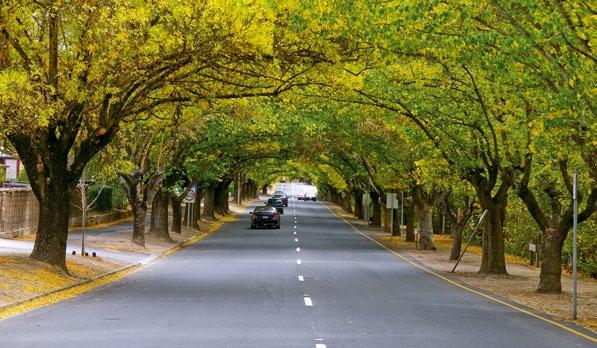
It is estimated Greater Adelaide is currently losing approximately 75,000 trees each year. New plantings, when they do occur, cannot keep pace with the consequences of these losses, especially when many of those lost are mature trees, which contribute far greater benefits than new plantings.
Urban green cover — the total area covered by vegetation — is diminishing at the rate of four Botanic Gardens each year, or the total area of the City of Campbelltown each decade. If this continues, there is no hope of reaching Adelaide’s target for an increase of 20% in our green cover by 2045.
The State Government’s new Planning and Design Code has failed to address the urgent need to protect our trees and green space. In fact, the code is likely to make matters worse by promoting further tree removal for high density developments and allowing developers to shirk their obligations to plant replacement trees by paying a pathetically small 'offset' fee.
A group of concerned individuals and organisations are launching a public campaign to save our trees
and demand action from the State Government to address tree losses across the State. The following measures have been identified as urgent and necessary to stem the precipitous decline.
Updating the definitions and exemptions for regulated / significant trees
• Changing the definitions and exemption provisions for regulated/significant trees.
• Expanding the range of trees classified as regulated/significant.
• Remove the 10 metre and 20 metre exemptions.
• Including additional policy in the Planning and Design Code in relation to tree canopy and incentives to retain trees.
• Increasing tree planting requirements for new developments and significantly increasing amounts to be paid in the offset scheme.
• Using qualified arborists to a greater extent in the planning assessment process.
• Dealing with applications for regulated/significant tree removal on development sites at the approval stage.
• Revising tree planting and payment offsets when tree removal is allowed.
• Providing more guidance regarding maintenance pruning of regulated/ significant trees.
• Increasing penalties for illegal removal and destruction of trees.
Supporting and engaging the community in caring for trees
• Providing funding to councils to identify individual trees and stands of trees that are significant for inclusion in the Planning and Design Code.
• Supporting homeowners to maintain regulated and significant trees on their properties.
• Greater use of incentives to encourage retention, such as discounts on rates for homeowners.
• Improving public engagement for development applications affecting trees.
With the introduction of the State Government’s new Planning and Design Code our planning system is being replaced by a development free-for-all, where rules are being ignored and the community is excluded from planning policy and development decisions. The consequences of these policies to encourage development at any cost are becoming more and more apparent with oversized, substandard and inappropriate developments being pushed across Adelaide.
The former Newmarket Hotel at 1 North Terrace has been a city landmark since it was built at the height of Adelaide’s 1880s boom. Since closing as a hotel in 2017, the site has been the subject of a number of redevelopment proposals. The latest, from a Singapore-backed developer, proposes a 32-storey tower behind the 1883 structure, requiring partial demolition of the original structure to create apartments and a range of commercial uses. An earlier proposal for two 23-storey towers was questioned for failing to meet minimum standards in terms of the floor areas of the apartments, and for being almost double the permitted height for the area. The new proposal is larger still. Whilst the developers continue to grow their proposal for the site, the original Newmarket Hotel has been the subject of vandalism, including serious damage to the original magnificent cedar and pine staircase. Neglect of the site’s heritage, and disregard of planning standards and constraints, do not augur well for the quality of this development.
become 13? The oversized apartment building proposed to replace a local heritage place in Glenelg.
Seawall apartments, Glenelg

On the South Esplanade at Glenelg, another massive development is being proposed in clear contravention of planning policies that restrict the height of developments to five storeys. A 13-storey building with 96 apartments is being proposed to the State Commission Assessment Panel (SCAP). The local council and community are questioning how such a proposal can be contemplated in clear contravention of the building heights policy, and including the demolition of a local heritage place — the Seawall apartments. Under the new planning rules, with reduced rights for community input and appeal of development approvals, the only recourse for objecting to an approval of this development by the SCAP would be a hugely expensive judicial review. The loss of appeal rights and the willingness of bodies such as SCAP (a body neither elected by nor accountable to the public) to approve developments in breach of existing policies, means we can expect many more cases like this.
From bad to worse? Burnside Council concludes it is better to approve a strongly-opposed service station development in Kensington Park than risk the possibility of something worse under the new Planning and Design Code.
Service station, Kensington Park

Residents of Kensington Park have fought a prolonged battle against the establishment of a 24-hour service station abutting residential areas on Kensington Road. After protracted legal appeals against the proposed development going as far as the Supreme Court, the Burnside Council has finally approved a modified proposal, despite major community concerns about traffic, safety and noise impacts. One of the factors in the council’s decision was a recognition that the proponent could most likely pursue “an even lesser desired development, shaped by the policies in the incoming Planning and Design Code”.
by
within residential areas as the lax standards set by the code take effect.
 Vaulting ambition while heritage languishes - a development proposal for the Newmarket Hotel site.
How does five storeys
Vaulting ambition while heritage languishes - a development proposal for the Newmarket Hotel site.
How does five storeys
Stand
for more oversize, substandard development proposals and further commercial developments
The State Government’s new Planning and Design Code reduces and undermines the planning policies and rules that have protected our built heritage for more than 40 years, paving the way for a demolition and development free-for-all in our most historic areas.
All buildings with a heritage designation — whether as state or local heritage, contributory items or part of an historic conservation zone — will now have less protection from demolition and there will be less regulation of what can replace them. The result will be a significant loss of historic buildings across the state and with them, the distinctive features and amenities that define many of our most loved and valued residential areas.
Norwood is one of the areas most likely to be impacted by the changes. It has a high number of properties that previously enjoyed robust local heritage protections under the former

Development Act. Many of the demolition controls and building design standards for this area have been relaxed or removed under the new Planning and Design Code, despite strong public objections to changes which were inadequately consulted upon and which still may not be fully understood by the owners of these properties.
The results of these changes will start to play out with new development applications to replace original building stock in historic areas with new builds, through the demolition of existing properties and smaller subdivisions. Original buildings which have not been well maintained will be particularly vulnerable to opportunistic demolitions, steadily eroding the distinctive qualities of our inner metropolitan areas and reducing the amenity of existing residents. Those who have invested in maintaining the original building stock of these areas will find their investment diminished by the growing incursion of less well designed and less well-made infill development.

Residential amenity will be further reduced by changes allowing more commercial developments, such as shops and offices, within established residential areas. Many of these changes have been contested by local councils and community advocates, but with little success as the State Government moves to relax planning standards and remove communities from decision making about new developments.
Much of the extensive work done by local councils in conjunction with their communities, over many years, to develop specific planning policies to protect the historic characteristics of local areas have been discarded under the Planning and Design Code. In their place, more generic policies and standards, lacking in detail and specificity, will put at risk all of the work done over the last 30 years by councils and owners to protect the historic features of our oldest residential areas.
Time will tell, but the losses could be unprecedented as the government’s development free-for-all is unleashed in our most historic areas.
PICTURED: Below: Historic buildings such as this one in Norwood are first in firing line as the new Planning and Design Code strips heritage protections to facilitate more demolitions and infill development.Capital works have begun for the exciting new Silver to Sea Way heritage tourism drive trail, starting with the iconic roundhouse at Peterborough, where restoration work is being guided by the original drawings, thanks to some useful detective work.

As featured in the last edition of Heritage Living, the National Trust of South Australia has received $6.594 million from the Australian Government’s Building Better Regions Fund for Stage 1 of the Silver to Sea Way. This new touring route stretches from Silverton/Broken Hill in New South Wales to Port Pirie in South Australia.
Major building regeneration works have been scoped for three sites during Stage 1 of the project from Port Pirie to Peterborough — the Peterborough Roundhouse, the old Gladstone Gaol, and the former railway station and customs house in Port Pirie. These major capital works projects will be supplemented by new visitor experiences and interactive displays along the route.
First of the capital works projects to get underway is the roundhouse, one of the main attractions at Peterborough and an integral part of the award winning Steamtown Sound and Light Show.
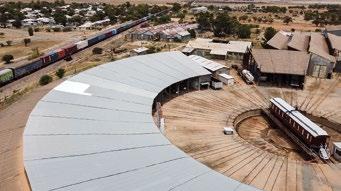
Designed and built in 1924 by Robert Hall Chapman for South Australian Railways, the roundhouse was one of three built at the same time, the others being Mile End and Tailem Bend, now both demolished. It contains some truly impressive pieces of timber, with some of the main columns being 10-inch (25.4 centimetre) square pieces of jarrah more than 30 feet (10 metres) tall.
The roof structure is largely composed of Oregon pine, also known as Douglas fir. The structure was originally clad in asbestos-coated steel sheeting, some of which is still in place. The original steel framing in the windows around the exterior is also still in place and in need of repair and remediation.
Due to weathering and termite damage, there has been some deterioration of the building over time. The project will involve structural assessment, remediation of the timber and the removal of all remaining asbestos products on site.
The work will be carried out by McMahon Services Services on behalf of the Trust. McMahon have been selected because of their previous
involvement with Steamtown, and extensive expertise in asbestos management and disposal. With local teams in the Mid North, McMahon Services is also keen to work with the Trust towards the project goals of providing local training and employment opportunities.
Thanks to some detective work by the National Trust and others, we have managed to locate the original drawings of the roundhouse, which have given us some vital information about the construction of the building, particularly the footings.
Made of jarrah, they are now at least 1.5 metres underground. While there appears to have been some sinking of the structure in spots, there are no plans at this stage to raise them to original levels as that would be likely to create more problems than it would fix. The existing roof will be replaced with sheeting produced in galvanised steel to match the original ‘Super-6’ profile. While the main posts are generally in good condition, some of the roof timbers have started to show signs of age and will also need replacing.
Thanks to more excellent detective work by the Mount Gambier branch of the Trust, we have discovered that timbers from the former Mount Gambier roundhouse are available to make the repairs. Regrettably, that building was demolished in 2019, however some of the timbers have been preserved. This will be a crucial supply component for the project, as timbers of this size and specification are simply not available today. The external posts will be retained where possible, and treated with timber preservatives to ensure their longevity.
With the newly uncovered original plans and timbers recovered from its Mount Gambier cousin, the Peterborough roundhouse is ripe for regeneration as one of the lynch pins of the SIlver to Sea Way experience. BELOW
Below: Part of the original drawings for the roundhouse, c.1924 (courtesy of Mark O'Malley, Refreshing Memories).

Master painter ben Cunningham shares his knowledge on painting heritage windows as part of the National Trust’s program to retain traditional skills and regenerate the State’s heritage buildings.
The National Trust’s Australian Artisan Trades Academy (AATA) provides practical learning opportunities in the applied use of the traditional trades and skills required to maintain and preserve our heritage buildings.
As part of the Trust’s building regeneration program, the Tea Tree Gully Heritage Museum received funding from the SA Heritage Grants Program to carry out urgent restoration work on windows in the main building, originally the Highercome Hotel, built in 1853. Master painter Ben Cunningham, from Watermark Painters, was engaged to remove layers of paint, and to replace old putty and areas of rotting timber.
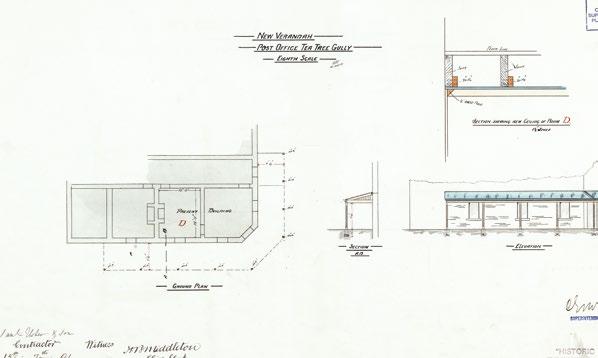
AATA project manager, Ali De Backer, seized the opportunity to interview Ben onsite as he worked, capturing his considerable knowledge in a twopart video now available for viewing on Youtube as part of the Trust’s commitment to documenting trades
involved in conservation and restoration processes, and producing learning resources that people can access in years to come.
Ben noted that the windows on the southern side of the building were in the worst condition, due to the prevailing wind and rain and their exposed nature. “We want them to function as windows,” he explained. “What’s happened with a lot of properties of this vintage is that they have been painted poorly, so essentially layers and layers of paint was probably what they thought was going to protect it. It did in a way but the problem with more paint is that it actually fills all the edges up, which means everything gets thicker. We’ve got examples on this place of between eight to 12 coats of paint.”
This had created what Ben calls fat edges, so the windows no longer opened. However, after working on the Tea Tree Gully Heritage Museum for several weeks the original windows are now all repaired, operable and painted inside and out.
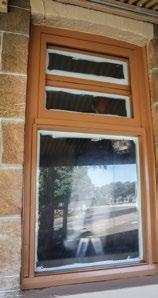
• Good preparation is key for any paint job.
• If multiple windows have to be removed for repairs, number them so they go back in the right spot.
• Safety first — removing old paint requires lead encapsulation and using dustless sanding systems.
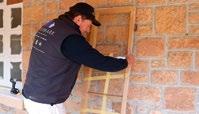
• Semi -gloss paint cleans well and shows fewer imperfections than high-gloss paint.
Ben reiterated the importance of lead awareness in older buildings, not just for listed properties but any properties built before 1975. He encourages homeowners to consider using a master painter, to reduce the risks of exposure to lead and working at heights.
To view the two-part video, visit Youtube and search for ‘Tea Tree Gully Heritage Museum Building Works’, or go to https://youtu.be/LWVBMANgTVAEnglish actor and television presenter Tony Robinson, was astonished to find the name Polites on so many Adelaide buildings when he did a bubbly series of historical ‘Time Walks’ through Australian cities a few years ago. Was it, he wondered, a reminder to visitors to behave properly? No, he said, it was just the result of an Adelaide property developer wanting to put his name everywhere.
On this occasion Robinson’s historical imagination failed him.
The Polites story is a unique tale of historical mishaps, migration and hard work, and a family who took the road less travelled. Like the famed American investor, Warren Buffet, the Polites strategy was to ‘buy and hold’ good assets –not to ‘buy and flip’.
Run-of-the-mill property speculators load themselves up with debt to buy old buildings, demolish, build and sell. Others board up perfectly serviceable historic buildings, and then wait for rising land values and changes in planning rules to deliver windfall profits – all the time bleating that it’s not economic to keep them going.
The Polites marched to the beat of a different drummer, spending their own (not borrowed) money on buildings that would pay their own way. Affordable rents ensured they stayed occupied most of the time.
Those who know their Homer will recognise Polites as the ‘most devoted and loyal’ member of the crew that accompanied Odysseus on his fabled journey home from the Trojan War. In modern times, ancestors of the Adelaide Polites family occupied high administrative positions in the decaying Ottoman empire. Their tragedy was to find that Greeks were no longer wanted in an ethnically-minded new Turkey. Their own odyssey led Constantine Polities’ parents to Port Pirie in distant South Australia, where Con was born in 1919. As a young man, he tried his luck in Sydney before returning to Adelaide where he soon acquired a few buildings. Hesitating to put a migrant name on his fledgling company, he borrowed the moniker of a chic Double Bay restaurant, Princes, and set about building his property group. Within a few years, the younger members of the family convinced him to nail their true colours to the masthead.
With the passage of years, the name Polites has proliferated on Adelaide buildings. Some are state and local heritage places. Many others deserve to be but remain unprotected by any listing.

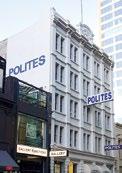


PICTURED
Not many glow, as they might with heritage colours and interior refitting. Most are painted a modest Greek white. But what matters to the National Trust is that they are still there. Most likely the Polites group looks after the biggest collection of heritage buildings in Australia. We owe them a huge debt of gratitude for retaining them and proving in the most dramatic, practical way that old buildings can be made to pay. Next time you pass one tip your hat, not just out of politeness but respect.
Celebrated every May, South Australia's History Festival explores our history through hundreds of diverse and fascinating community events across the State. In this special Heritage Living feature, we highlight just a handful of the events being organised by the National Trust of South Australia in 2021, from guided walks and behind the scenes glimpses of some of Adelaide’s most significant buildings, to hands-on workshops, storytelling sessions, May Day celebrations and a special Mother’s Day concert.
For more event listings go to the What's On section (pp 31-33).

For more information about South Australia’s History Festival and to book tickets visit www.festival.history.sa.gov.au
 PICTURED:
Above: Walkers enjoying the challenge of the Pioneer Women’s Trail Walk.
Below: Electra House on King William Street, a feature of the Heritage Reborn guided walking tour.
PICTURED:
Above: Walkers enjoying the challenge of the Pioneer Women’s Trail Walk.
Below: Electra House on King William Street, a feature of the Heritage Reborn guided walking tour.
About 180 years ago, as the clock struck midnight, women from the German pioneer settlement of Hahndorf were pulling on sturdy boots and shouldering baskets of fresh produce, readying for a long walk to the markets in Adelaide. Since 1980, thousands of walkers have followed in the footsteps of these pioneering women, rambling the 26km from Hahndorf to Beaumont House for the annual Pioneer Women’s Trail Walk. A popular highlight of the Trust’s event calendar, the walk is the longest and most challenging of several being offered during the 2021 History Festival.

People who prefer a more leisurely stroll along city streets can experience North Terrace through the eyes of another pioneering South Australian, Sir Henry Ayers, who spent his days striding between Old Parliament House and his family home, Ayers House. This guided tour is part of celebrations marking his 200th birthday. Alternatively, join the Colonial Gems guided walk from St. Peter’s Cathedral up to the ‘Light’s Vision’ lookout atop Montefiore Hill, and explore why Pennington Terrace, complete with stunning architecture and city views, was once home to some of Adelaide’s highest society. Stepping back into modern-day Adelaide, the Heritage Reborn guided tour encourages walkers to marvel at how heritage buildings in the city centre have stood the test of time and been transformed to suit new and unique purposes.
Henry’s Adelaide: 1-2:30pm, Saturday, 1 May.
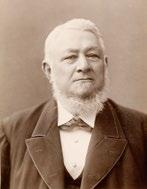
Heritage Reborn: 10am, Thursday, 20 May.
Pioneer Women’s Trail Walk: 7:30am-4:00pm, Sunday, 16 May.
Colonial Gems: 10am, Sunday, 30 May.
 PICTURED:
Top right: Sir Henry Ayers, c. 1890 (State Library of SA B6191).
Above: Carclew House on on Jeffcott Street. part of the Colonial Gems guided walking tour, 2016 (photo by denisbin, Flickr).
PICTURED:
Top right: Sir Henry Ayers, c. 1890 (State Library of SA B6191).
Above: Carclew House on on Jeffcott Street. part of the Colonial Gems guided walking tour, 2016 (photo by denisbin, Flickr).
Original home for the Angas family estate, Collingrove in the Barossa Valley boasts an ornate Weber baby grand piano, custom-made for its drawing room in the 1910s. Reported to be one of the most expensive models of piano in the world at the time, it has a unique, mellow sound perfectly suited to its surroundings.
The piano will take centre stage in a special intimate afternoon concert curated by the National Trust’s artist in residence, Celia Craig. The former principal oboist with the Adelaide Symphony Orchestra will be supported by Michael Lerace, an award-winning concert pianist and graduate from the Elder Conservatorium of Music; and cellist Thomas Marlin, who is a graduate of the Guildhall School of Music and Drama. The emotionally compelling program will feature nostalgic Edwardian salon pieces by Elgar and Bridge, lyrical and intimate chamber music in trios, modern solo piano pieces by Gershwin and Grainger’s unforgettable Colonial Song
Original Baby Grand Afternoon Concert: 4pm, Sunday, 9 May.
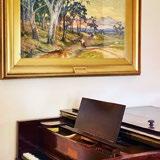
On 1 December 1948, an unknown man was found dead on Somerton Beach. He carried no form of identification and his death sparked international intrigue. The mystery of his identity remains unsolved today. Join this popular walking tour starting from Ayers House and follow the evidence to retrace the Somerton Man’s final day in the city.
Or head north-east of the city and explore another unsolved mystery, which haunts Tea Tree Gully. In 1970, a strange and terrifying creature was sighted. Nicknamed the Houghton Howler, the creature was said to resemble a thylacine. However, it soon disappeared without a trace. For a night of ghost stories and urban myths, meet with others intrigued by this tale at the Tea Tree Gully Heritage Museum.
Unlike the Somerton Man and the Houghton Howler, criminals at the Willunga Courthouse were not only caught, but also identified. Yet, their shocking deeds have been all but forgotten. Delve into Willunga’s heinous past and uncover its dark secrets at a special event for the History Festival.
Night of the Houghton Howler: 7pm, Friday, 7 May.
Somerton Man Mystery: 10am, Saturday, 8 May.

Willunga’s Wicked Ways: Criminals, Crime, and Constables: 2pm, Sunday, 30 May.
PICTURED:
Top left: The custom-made Weber baby grand piano at Collingrove. Above: Part of an encrypted message connected with the Somerton Man mystery.A series of events throughout May will take participants on guided tours of four Adelaide heritage buildings, including spaces normally inaccessible to the public. From colonisation to the Second World War, the Old Treasury building sat at the very heart of South Australia’s political life. In a welcome return after last year’s disruptions, the popular guided tour of one of the city’s oldest buildings is back for the History Festival. Above ground, explore winding hallways and meet colourful characters from the treasury’s past. Heading below, journey through underground chambers and tunnels, walking the passageway where gold from Victoria was stored before being smelted into Australia’s first gold coin.
For those interested in a very different side to South Australia’s past, the former Glenside Mental Hospital occupies a unique place in the State’s history. For almost 90 years, Z Ward was home to people classified as ‘criminally insane’. Designed by E.J. Woods and completed in 1885, the ward’s innovative architectural features include a Ha-ha — a deceptive ‘wall’ which encircled the building, providing added security.
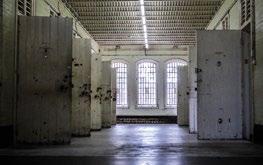
Opened in 1870, the North Adelaide Baptist Church in Tynte Street is one of the city’s most iconic and unusual church buildings. Since it was gifted to the National Trust last year, extensive conservation work has begun to carefully restore and maintain it. In a special tour and presentation for the History Festival, go behind the scenes to explore the building and find out more about this process and some of the technical challenges encountered.
Alternatively, spend the evening touring Ayers House by candlelight. Although the butler, housekeeper and cook are busy preparing for an upcoming State Dinner, they will have just enough time to show you around Sir Henry Ayers’ grand home on North Terrace. Follow them as they go about their duties and learn what life was like working in one of Adelaide’s finest houses during the 1870s.
Restoration of the North Adelaide Baptist Church
Behind the Scenes Tour: 10am, Monday, 17 May, and Monday, 24 May.
After Dark: 6.30pm, Thursday 6 May, Friday 7 May, Thursday 20 May, Friday 21 May.
Z Ward — Behind the Walls: 2pm, Saturday, 1 May, and Sunday, 23 May.
Old Treasury and Tunnels Tour: 1pm and 3pm, on Sundays in May.
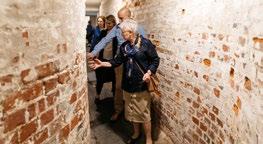
 PICTURED:
From top: An After Dark performance at Ayers House Museum; exploring the Old Treasury building tunnels (photo Sia Duff); and the former Z Ward asylum for the criminally insane at Glenside.
PICTURED:
From top: An After Dark performance at Ayers House Museum; exploring the Old Treasury building tunnels (photo Sia Duff); and the former Z Ward asylum for the criminally insane at Glenside.
Arare sack-back gown designed for promenading in the Grand March to open an important ball will be the centrepiece of a special exhibit at Ayers House every weekend in May. Thought to be the only gown of its type held by any museum in Australia, it is one of the most precious items in the National Trust of South Australia’s costume collection. Very little is known about the gown, other than it was worn by a Mrs Henderson at a Viennese ball in 1752. One could speculate that she was the wife of a British officer who fought alongside Austrian forces in the War of Austrian Succession, between 1740 and 1748. In that capacity, he and his wife may have received an invitation to attend a celebration ball such as that hosted by Empress Maria Theresa of the Theresian Military Academy in Wiener Neustadt, Austria, in 1751.

The gown is an excellent example of a ‘Robe a la Francaise’, made of silk brocade with a cream background and sprigs of burgundy flowers. As with all sack-back dresses, it is heavily decorated with ruffles, ruching, lace and embroidery.


Worn over wide side panniers, this style also features a fancy petticoat, a redingote with pleated train flowing from the shoulders, and stomacher. Unfortunately, the stomacher was not provided to its collector with the dress.
Even though the garment is now very fragile, it is a tribute to the maker’s craftmanship that it has survived 270 years, including a likely long sea voyage to Australia. However, due to its delicate nature, it is important to note this will be the last time the gown will go on public display. Like all grand old ladies, she deserves her rest! The gown will be supported in the exhibit by a collection of designer-label garments dating from 1910, including the creations of two designers
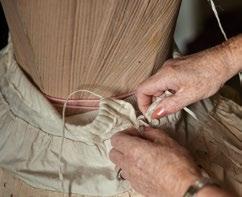
An afternoon fashion parade at Ayers House will bring to life the glamour of garments from the 1750s to the 1950s. The event will feature quality reproductions of the historic gowns on display during the History Festival, including the stunning Vienesse ball gown.
with Royal connections — Reville & Rossiter, who designed Queen Mary’s Coronation Robes, and Norman Hartnell, who was dressmaker to the late Queen Mother and Her Majesty Queen Elizabeth II. A Le Long gown from the 1940s war years in Paris will also be on display, together with a gown made by Chambrelent, who managed the Worth Salon in the same period.
PICTURED:
Opposite page: The rare Viennese sack ball gown, c. 1752. Top: Costume collection honorary curator Sandy Whitelaw and volunteer Kelly Pop carefully unpack the gown and prepare it for display. Above and left: Some of the gown’s exquisite detailing. Photos by James Field Photography.
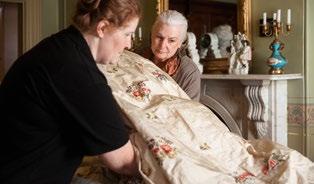
The Viennese gown will only be on display during May at Ayers House Museum which is open on weekends 10am- 4pm.

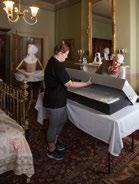
Date: Saturday, May 15
Time: 1.30 pm to 3 pm.
For more information about South Australia’s History Festival and to book tickets visit www.festival.history.sa.gov.au
Based around the classic fairy tale Jack and the Beanstalk, a fun day out for the whole family will mark the beginning of the History Festival at Ayers House Museum. Listen to the story being told the traditional way, with no need for a book. Follow Jack’s adventure through the clouds, come back down to Earth and make either your own Jack in the Beanstalk or rocking cow to take home. Stay after the storytelling session to explore the museum, dress up in Victorian-era clothing for a family portrait, or write a letter at Sir Henry Ayers' desk.
Meanwhile, adults can develop their creative skills at two workshops to be held at Stangate House and Gardens. Led by the SA China Painters Association, the first workshop will explore the history of porcelain painting in South Australia and give participants the chance to paint their own tile or coaster. Alternatively, learn about the art of signwriting with Peter Foster, master sign-writer, coach builder and wheelwright. Traditionally, house names were painted, carved, or embossed in metal nameplates. This workshop will introduce participants to both the art of setting hand-painted letters and to the tools needed to complete the work.
Jack and the Beanstalk at Ayers House Museum: 10:30am, Saturday, 1 May.
Paint Your Own Porcelain Tile: 10am, Friday, 7 May.
Design Your Own House Name Plate:

PICTURED:
Above: Create your own Jack and the Beanstalk at Ayers House Museum.

Below: A hand-painted porcelain plate.

Are you interested in knowing more about the history of your house? The National Trust is offering a free, non-accredited course designed to provide you with all the information you need. Using a variety of free online tools, this course covers searching for the title of your home and how to effectively use old street directories and newspapers.
Meanwhile, the Tumby Bay branch will be hosting weekly readings from the diaries of families with longlasting connections to the Eyre Peninsula community. The live readings at the Tumby Bay Museum, every Wednesday in May, will be streamed through the museum’s Facebook page for people who cannot attend in person.
Research the History of Your House: Friday, 1 May to Sunday, 31 May.
Historical Diaries on Eyre Peninsula: 2pm, every Wednesday during May.

10am, Saturday, 8 May.
A special May Day march taking in sites of historic significance for unions will be held at Port Adelaide on 1 May, as part of celebrations marking the centenary of the unique Port Adelaide Workers Memorial. Unveiled in 1921, the memorial remains the only Lady of Justice statue in the world erected in recognition of the fight for justice for workers. This year’s march will culminate in a street party on Nile Street, with bands, speeches, food trucks and bars, a petting zoo and an auction.
Initiated by the Port of Adelaide branch of the National Trust, the event is a joint collaboration with the Port Adelaide Enfield Council, SA Maritime Museum and the May Day Collective, which has involved gathering stories about people whose names are featured on the memorial.
The celebrations also include an exhibition featuring the largest display of trade union banners ever seen in Australia, dating from the early 20th century to the present day. The Marching for Justice exhibition will be held at the Maritime Union of Australia Meeting Hall on three weekends during May. Visitors to the port can also explore the history of the memorial and union contributions to the welfare of South Australian workers through two guided walks, featuring large-scale paste-ups of historical images.
May Day in the Port: 1-5pm, Saturday, 1 May.
Marching for Justice exhibition: 10 am to 4 pm, Saturday, 1, 8 and 15 May; and Sunday, 2, 9 and 16 May.
Port Adelaide Workers Memorial Centenary Pasteup Artworks guided walks: 4 pm, Saturday 1 May and 2 pm, Sunday, 9 May.
For more information about South Australia’s History Festival and to book tickets visit www.festival.history.sa.gov.au
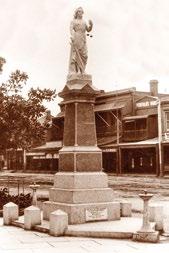 ABOVE:
ABOVE:
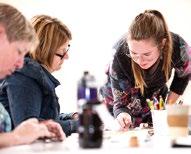
 HELEN LAWRY
HELEN LAWRY
A talented young Adelaide Hills artist is sharing her love of nature and her skills in a series of popular workshops hosted by the National Trust at Stangate House.
As a child, Zinia King loved drawing and making up stories. Now a professional watercolor artist and children’s book illustrator, Zinia lives in the Adelaide Hills where she finds inspiration in the local flora and fauna.

Zinia graduated from the University of South Australia in 2015 with a Bachelor of Design — Visual Communications degree. She was one of four students nominated by the university for the Design Institute of Australia’s Graduate of the Year Awards (GOTYA), which celebrates exceptional designers in the early stages of their career.
Since then, Zinia’s artworks have been featured in major exhibitions and her own children’s books. She has completed private commissions, worked as a graphic artist, taught art classes and taken her artworks to Adelaide design markets such as Bowerbird and Gathered.

The collaboration between Zinia King and the National Trust began when the gift shop at Ayers House started stocking her greeting cards, which feature Australian flora and fauna. After learning that Zinia taught watercolour workshops, it seemed natural to invite her to deliver them at Stangate House in Aldgate, as part of a series planned by the Trust’s Experiences and Engagement team.
We sought a variety of artists willing to run intimate workshops for up to 10 people. To date we have hosted artists who work with fused glass, embroidery and nature writing, often referencing the beauty of Stangate’s garden. Participants frequently comment that being in a beautiful place and making time to do something artistic leaves them feeling replenished. With morning tea served as part of each event, perhaps drinking from fine china and eating homemade biscuits helps reinforce the feeling of being nurtured too!
Collaboration with the National Trust allows Zinia to share her talents and unique style with the community while also providing her with income, which is especially important given the difficulties posed by the uncertainties of 2020. Offering a series of workshops with the artist also means participants can choose to refine their technique by going to multiple sessions.
JOIN
and spend a morning learning and creating in one of the Trust’s most inspiring places. Workshops are planned for June 17, July 8, August 19, September 30, October 21 and November 18, 2021. For more information and bookings follow us on Facebook at facebook/stangatehouseofficial; or email bookings@nationaltrustsa.org.au
ABOVE:
ZINIA KING AT STANGATE HOUSE AND GARDEN HELEN LAWRY
HELEN LAWRY
Home schoolers like to get out and about for educational experiences but their unique needs are often overlooked by venue managers, limiting the opportunities. The National Trust has been working to fill that gap.
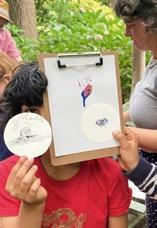

Home schoolers look for educational experiences in interesting places where both children and parents from a small group of families can gather together and strengthen social bonds as well as learn. Unlike most school groups, which are made up of students from one class or year level, they also need access to programs that cater for multiple levels of learning, with students in one group sometimes ranging in age from six to fourteen. National Trust properties offer opportunities in spades, so we have been working with home-schooling families to find the best way of giving them enjoyable, educational activities in our unique settings. The programs set up for them are similar to those made available to regular school groups, but adapted to suit a diverse range of ages and needs.
At Ayers House Museum, children can do the ‘Spit and Polish’ servant training program, the ‘Think and Ink’ tour or try the ‘Mind Your Manners’ experience. Home school groups may also choose the ‘Young Kate’ storytelling and artbased program in the idyllic Stangate House garden. Writing workshops and tours are available for secondary level students at Z-Ward and Ayers House Museum.
While we have catered for home school groups for several years, last year we consulted directly with parents to improve and inform how our programs are run, and the best way to manage publicity and ticketing.
One parent told us: ‘We really appreciate your educational programs as not only do you provide the ticketing system, but you provide an interesting venue as well as a professional and unique program that covers many areas of the curriculum. As a mum, I appreciated being able to take part. I appreciate the affordable price point and love having my children’s interests met. They both love history and are interested in the olden days. I love being able to spend time in these venues and the facilitators are just so good with the children.’
The children seem to enjoy the experience too. Here are some comments from primary-aged participants, reflecting on visits to Ayers House and Stangate:
'It was much more special being in an old house and learning about the olden days. We were able to imagine it more.'
'I liked playing in the garden and doing the painting and doing it with my friends.'
'I liked how the garden was so green and they we could explore. I liked the recorder. I liked the story. The message was "Let people be free and don’t give up on your vision".'
We look forward to continuing our partnership with the home-schooling community and are sincerely grateful that we can all get ‘out and about’ again.
Helen Lawry manages school and family programs for the Trust.
PICTURED:
Top and centre: Students being inspired by the gardens at Stangate House.
Above: Visiting Z Ward.
A recently-published book written by volunteers from the National Trust’s Glencoe branch, explores the murky past of the Leake family, and the surprising life of a young colonial woman, who inherited their fortune.
The front cover of The Accidental Heiress carries an extraordinary 19th-century photographic portrait of a young woman with a steady gaze and unconventional cropped hair, holding a boomerang. Letitia Sarah Leake was the daughter of Edward Leake, who established Glencoe station in 1844 with his older brother, Robert.

Uncovering her tale began with the simple idea of writing a short story about the people who built Glencoe woolshed, which was donated to the National Trust in 1976 by Scotty Kennedy. When research uncovered some surprising and scandalous information, the story turned into a book authored by John Berger and Carol Grbich.
Robert and Edward were sons of a successful merchant family, who settled in Tasmania in the 1820s. The two brothers came to South Australia soon after it was settled, and eventually settled on land around Lake Leake, where they established an estate covering some 630 square kilometres.


Robert was a serious minded man, but Edward took a fancy to a young Irish girl already married to a bullocky. After the bullocky mysteriously disappeared, Edward proposed. When Robert died childless, Edward inherited Glencoe where he built one of the finest woolsheds in the colony in 1863. He died four years later and left the bulk of his estate to his seven-year-old daughter. Letitia came into her inheritance when she turned 21. A few years later the estate was sold to the Riddoch brothers for the equivalent of $25 million today. As a wealthy woman, Letitia had many suitors, but she took her time before settling on Charles Billyard, a lawyer and son of the New South Wales Solicitor General.
When the honeymoon was over, Charles examined Letitia’s finances and found some irregularities. He demanded restitution from the trustees, which led to acrimonious legal proceedings against Letitia’s family and the banks, who conspired to discredit her rights to the entire estate. They hired a lawyer to find proof she was illegitimate and investigate her father’s possible involvement in the bullocky’s death. The investigations turned up a lot of malicious gossip and hearsay but no solid evidence and the matter was settled out of court in Letitia’s favour.
After the dust had settled, she and Charles left Australia and bought Harefield Park in England. When war broke out in 1914, they offered the property to the Australian government as a hospital for Australian soldiers. Having lived an extraorindary life that took her from the isolated bush of the South East to high society in England, Letitia died in 1923 at the age of 64.
The Accidental Heiress: Journey of a Glencoe squatter’s daughter was published with assistance of a $5000 grant from the History Trust of South Australia. The book is available from the National Trust, Collins bookstore in Mount Gambier, Glencoe Country Post and Bistro, various Tourist Information Centres in the South East and Adelaide Booksellers in Adelaide. PICTURED:A kaurna man with a unique combination of skills and experience has collaborated with the National Trust branch at Tea Tree Gully to create a new display.
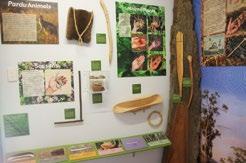
When the Tea Tree Gully Heritage Museum decided to commission a permanent display showcasing the stories and culture of the Kaurna people of the Adelaide Plains, it had a very clear focus. The project brief asked for Kaurna history to be interpreted by a Kaurna person, so their true story could be told, read and acknowledged.

After consulting with Kaurna Elders, it was agreed the museum team would work with James Tylor, a Kaurna man with experience as a researcher, historian and writer. James trained and worked as a carpenter in Australia and Denmark. He also studied visual arts at the South Australian School of Arts and Tasmanian School of Art.

All of these skill sets were put to use in creating the display, which incorporates his storytelling, photography and hand-crafted objects. “James is based in Canberra so many phone calls and emails took place,” branch chair Gill Starks said of the experience. “What an educational, inspiring, passionate journey he took us on as we worked our way through information, text and images!”
James used traditional materials and techniques to make the objects, which include spears, yuku (coolamon), tantu
(a kangaroo skin bag), clubs, a broad shield, fire stick and digging stick.
The exhibition also features information about the yarta (land), warra (language), mairna (plants) and pardu (animals) of Kaurna land. It explains the traditional five seasons of the Kaurna calendar, providing information about the main foods available in each season and where they might be found, as well as discussing traditional seasonal migration patterns.
A section on history presents the story of the establishment and development of the colony of South Australia from the Kaurna perspective. This part of the display provides local perspectives on national narratives such as Stolen Generations and the 1967 Referendum, when Australians voted in favour of including Aboriginal people in the census. Launched in March, the display was designed by Richard Browning, with funding from the History Trust of South Australia’s MaC program.
The National Trust of South Australia acknowledges and respects Aboriginal peoples as the State's first peoples and nations, and recognises Aboriginal peoples as traditional owners and occupants of land and waters in South Australia. Further, that their spiritual, social, cultural and economic practices come from their traditional lands and waters, that they maintain their cultural and heritage beliefs, languages and laws which are of ongoing importance, and that they have made and continue to make a unique and irreplaceable contribution to the state.
The Tea Tree Gully Heritage Museum is open to the public on the 3rd Sunday of every month, from 11 am to 4 pm. For more information visit www.nationaltrust.org.au/places/tea-tree-gullyheritage-museum/
 PETER FOSTER OAM
PETER FOSTER OAM


Vehicles collected by three South Australian visionaries are the nucleus of the National Trust’s State Horse-Drawn Vehicle Collection, now regarded as Australia’s finest.
Seven years after the formation of the National Trust of South Australia in 1955, two Adelaide members, Tom Downer and Clive Corbin, started to seek suitable vehicles for a collection they had in mind.
Clive and his wife, Jo, were avid collectors of fine silver, which they obtained through auction houses both in Australia and overseas. This interest in antiques drew Clive into becoming an active member of the Trust. Collecting and conserving occupied him from an early age, amassing postage stamps and cigarette cards, which he carefully mounted and precisely documented.
From silver and small two-dimensional objects, Clive's collecting instinct led him to horse-drawn vehicles. He enjoyed the process of discovery, restoration and maintenance of an expanding collection. His pleasure came from showing it off and discussing it with interested members of the public.
Tom Downer was the horseman of the two, well suited to 'horsey’ conversation. ‘Clive Corbin and Tom Downer had an interesting relationship with one another,’ explained Clive’s stepson, Rory. ‘Tom knew a great deal about horses and their use in transport (Clive knew very little on these topics) but was less interested in the paperwork that was inevitability necessary as the collection grew. The two of them made a good team, complementing one another's skills and interest.’
 Tom Downer (at right) Clive Corbin Dr David Harris
Top: A fine landau from the Trust’s collection, previously owned by the Rounsevell family, who ran a livery stable in Adelaide. Likely to be Englishbuilt and quite expensive to purchase (upward of £100), it is well-sprung with c-springs, which were old-fashioned for the times but lent a certain dignity.
Tom Downer (at right) Clive Corbin Dr David Harris
Top: A fine landau from the Trust’s collection, previously owned by the Rounsevell family, who ran a livery stable in Adelaide. Likely to be Englishbuilt and quite expensive to purchase (upward of £100), it is well-sprung with c-springs, which were old-fashioned for the times but lent a certain dignity.
While Clive was chairman of the Trust in 1962, a horse-drawn vehicle committee was formed. Its aim was to collect a broad range of horse-drawn vehicles and associated items.
Tom had an ongoing involvement with a number of clubs, being a playing member of the Adelaide Polo Club, life member of the Onkaparinga Racing Club, and past master and president of the Adelaide Hunt Club. He went on to serve as chairman of the Trust’s horsedrawn vehicle committee from 1968 to 1980.

Tom chose to launch the collection in the style of the true horseman, at an event combining the official opening of the Adelaide Hunt Club season. Applying great skill, he drove his recently acquired 12-seater drag, pulled by a five-horse team which he handled with swagger. For both Tom and Clive, much keen bargaining and astute collecting was to follow.
Equally determined, Dr David Harris OAM was a driving force behind the establishment of National Trust museums and branches in both Robe and Millicent. The Millicent branch was founded in 1960. Like most country branches, its major thrust was to preserve the history of the town and its rural environs.
The museum was established to tell the story of the town based on six themes — Aboriginal culture, agriculture, way of life, drainage, the timber industry and early transport. Although the edges of these themes blurred over time, they allowed David and his team to collect broadly.
It mattered little if an object was large or small, David's unbounded enthusiasm saw it secured. Three of the largest items he acquired were a steam traction engine, threshing machine and steam locomotive.
After David’s death, local politician Dale Baker recalled: ‘He was forever seeking the unusual, a governess cart or a hearse. His wish was that, on his passing, he would like one of the collection’s hearses as his conveyance, unfortunately circumstances prevented it.’
Working together, Clive, Tom and David were determined to save the final vestiges of the previously allencompassing transport system — the horse-drawn vehicle. The collection they established became a reminder that the horse-drawn vehicle, and its power source, the horse, played a major role in Australia's development in the 19th and early 20th centuries. Each vehicle was acquired with the definite purpose of forming a comprehensive collection, showing a variety of vehicle types, styles and uses. In addition, they collected associated harness, lamps, and tools of the essential trades of harness-maker, wheelwright, coachbuilder and coach painter.
I am often asked, as I go about identifying, restoring and conserving horse-drawn vehicles and their associated tack, what area or areas of this mix are most important.
My response is swift — the identifying of those things which must be saved, thereby setting aside milestones of our history, which inform us of a particular time in our national progress. To the three men who shared this vision, we are deeply indebted.
The National Trust horsedrawn vehicle collection is on permanent display at the Millicent National Trust Museum.
*This article introduces a new series featuring items from the State Horse-Drawn Vehicle Collection written by the collection’s Honorary Curator and advisor, Peter Foster OAM. PICTURED:1 year 3 years
MEMBERSHIP CATEGORIES (save 10%)
4 children under 18 years)
(Two concession card holders or full time students and up to 4 children under 18 years)
Name of individual or first household member
Mr/Mrs/Ms/Other: First name: Surname:
Address: Phone (Home): (Work): (Mobile):
Email: Date of birth / /
Name of second household member
Mr/Mrs/Ms/Other: First name: Surname:
Email: Date of birth / / Full Time Student or Pension Card Number (if applicable) 1 2
Gift membership Only: Tick this box if you would like the gift membership gift pack to be posted to you at your address. Please provide details below.
Mr/Mrs/Ms/Other: First name: Surname:
Address: Phone (Home): (Work): (Mobile):
Email:
If you would like your membership to be affiliated with a ‘Local Branch’ please tick
Conditions of membership
Concession memberships apply to Australian Pensioner, Concession Card holders, Healthcare Card holders, Disability Concession and full-time students. Memberships are not transferrable. Only the person named on the card may use it. Your current membership card must be presented to gain free or discounted entry.
COMPLETE SECTION BELOW IF RETURNING BY MAIL OR EMAIL
Enclose a cheque payable to National Trust of South Australia or complete the credit card details below.
Card Holder Name Card Holder Signature
Debit my credit card: Visa Mastercard Expiry Date
Credit Card Number
Cost of membership/s: $
Post completed membership form to: National Trust of South Australia

Memberships PO Box 3131 Rundle Mall SA 5000
Or scan and email to: members@nationaltrustsa,org.au
Or call (08) 8223 1234
By becoming a member of the National Trust you will enjoy a range of discounts and other benefits, including free entry and discounts to many National Trust properties in Australia and around the world, as well as supporting our ongoing work to protect and preserve our heritage.
Two stalwarts of the kingston branch of the National Trust were recognised in the Australia Day Honours List this year for their services to the community.
Frank England and Alison Stillwell both received a Medal of the Order of Australia (OAM).
Agenerous donor and tireless community volunteer for more than 70 years, Frank England was honoured for his contribution to a range of organisations, including the National Trust, the Kingston show society and the Royal Flying Doctor Service.
Frank joined the National Trust in 2005, when he retired from farming and moved into the town. Serving on the branch committee and as a volunteer guide, he was instrumental in establishing and maintaining the gardens around the Cape Jaffa Lighthouse. He provided a bore and set up irrigation for the gardens, and assisted with fencing for both the lighthouse and the museum.
Frank is particularly passionate about the lighthouse and enjoys sharing his deep knowledge of its history. Records indicate that he showed more than 6000 visitors through the lighthouse outside formal opening hours alone, while he was on site tending the gardens.
His volunteering life began in 1948, when he became a sheep steward at the Kingston show. Frank also donated land for the Kingston Medical Centre and retirement village, and has been a philanthropic supporter of the Royal Flying Doctor Service for almost 30 years, with the Adelaide headquarters operations room named in his honour in 2014.
Ateacher by profession, Alison Stillwell joined the National Trust after becoming curious about the view from her kitchen window. She and her family moved to the town in 1986 when the former lighthouse keepers’ cottages were available for education department housing. After falling in love with the cottage and its view of the lighthouse, the Stillwells bought one.
Alison has been secretary of the branch and a volunteer guide since 2015. She coordinates the roster of lighthouse guides and information presentation for the town’s heritage markers. Alison also instigated development of the Margaret Brock shipwreck display, which received a highly commended award in the 2017 Museum and Galleries National Awards. Over a period of more than 30 years, as a piano teacher and accompanist, she has lent her musical skills to a range of local organisations including the Lutheran church, Kingston Community Theatre Group, which she co-founded, the Kingston Community School and Robe Primary School choirs, and the South East Primary Schools’ Music Festival. Alison has been chair of the Kingston Community School’s governing council, president of the Kingston SE Triathlon, serving on the committee for 18 years, and president, secretary and a coach with the Kingston Saints Netball Club.
Kingston branch president James Ringshaw praised both recipients for their valuable contributions to the Trust and the wider community. “They are both passionate about history, and have played very significant roles in conserving our heritage and sharing that enthusiasm with others,” he said.
 PICTURED:
Australia Day honours recipients Alison Stillwell and Frank England outside the Cape Jaffa Lighthouse
PICTURED:
Australia Day honours recipients Alison Stillwell and Frank England outside the Cape Jaffa Lighthouse
PICTURED:

Clockwise from left: Volunteers picking olives at Beaumont House, in conjunction with pruning the old trees; a healthy harvest; and Sir Samuel Davenport in the olive grove he established at Beaumont. c 1900 (State Library of South Australia B 6106).

In a ‘new’ tradition for beaumont House, volunteers are invited to join us on Sunday 16 May for the annual harvest of olives from our heritage-listed olive grove.
Aside from being a well-known pioneer, politician and extensive landholder, Sir Samuel Davenport is generally regarded as the father of the olive oil industry in South Australia. A keen promoter of agriculture and new industries in the colony, he experimented with olive growing, as well as growing lavender for perfume and mulberries for an emerging silk industry.
In 1856, Davenport purchased the property now known as Beaumont House, where he planted an olive grove based on oil-producing varieties obtained from Spain and Gibraltar. The grove eventually covered 27 acres, producing an average of 22 tonnes per year between 1894 and 1923. Production on a commercial scale continued until the mid-1960s, when cheap imported oil made it unprofitable. While most of the trees were removed, a remnant survives today and is State heritage listed.
In May 2017, National Trust volunteers who work in the house gardens harvested olives from the grove for the first time in about 50 years. With the support and guidance of Olives SA members, the volunteers hand-picked the olives, which were then crushed by Domenic of Diana Olive Oil at Willunga and bottled. The 250 ml-bottles proudly display a facsimile of the original Davenport Olive oil label used by Sir Samuel Davenport and later his nephew G.F. Cleland. This year the Trust is inviting volunteers to join us for the annual harvest, on Sunday 16 May. Experts will be on hand to demonstrate how to harvest olives. Participants are asked to bring along their own gloves and a clean bucket. They are also encouraged bring a picnic lunch to enjoy at long tables under the olive trees. As a thank you, participants will be able to take home some of the larger olives suitable for pickling and a recipe.
Olive picking runs from 8.30 am to 2.30 pm. For more information, please contact Merilyn Kuchel at mdkuchel@bigpond.net.au


Adelaide Tours
Henry’s Adelaide
Experience Victorian-era Adelaide through the life of prominent public figure Sir Henry Ayers ending at his former home for light refreshments.
Saturday 1 May
Time: 1.00pm – 2.30pm
Cost: Adults $25, concession $22, NT members & children aged 5 –15 $20.
Place: Starts at Ayers House Museum, 288 North Tce, Adelaide Enquiries: bookings@nationaltrustsa.org.au or 8223 1234
Book: https://bit.ly/henrysadelaidetour
Heritage Reborn
Whether it’s the dazzling transformation of Electra House or the quirky local artists inhabiting the Gothic Revivalist Epworth Building, you’ll be struck with a new appreciation for classic architecture and the innovative ways it can be reimagined.
Thursday 20 May
Time: 10am
Cost: Adults $15, concession $13, NT members & children aged 5–15 $10
Place: Starts at Electra House, 131-139 King William Street, Adelaide Enquiries: bookings@nationaltrustsa.org.au or 8223 1234
Book: https://bit.ly/heritagereborn
Somerton Man Mystery
On 1 December 1948, an unknown man was found dead on Somerton Beach, sparking international intrigue. More than 70 years later, the 'Somerton Man' remains one of our enduring mysteries. Retrace his final movements and revisit the clues that captured imaginations around the world.
Saturday 8 May
Time: 10am
Cost: Adults $15, concession $13, NT members & children aged 5 –15 $10 Place: Starts at Ayers House Museum, 288 North Terrace, Adelaide Enquiries: bookings@nationaltrustsa.org.au or 8223 1234
Book: http://bit.ly/zward
Z Ward: Behind the Walls
Neither prison nor hospital, the “criminal ward” of the former Glenside Mental Hospital occupies a unique place in history. Explore its rare Hah-ha wall, striking brickwork and sobering stories.
Saturday 1 May, Saturday 23 May
Time: 2pm
Cost: Adults $15, concession $13, NT members & children aged 5–15 $10 (not recommended for children under 12) Place: Z Ward, via 63 Conyngham Street, Glenside Enquiries: bookings@nationaltrustsa.org.au or 8223 1234
Book: http://bit.ly/zward
Australian Artisan Trades Academy
Paint Your Own Porcelain Tile
Come and try traditional techniques for painting on porcelain in a workshop led by the SA China Painters Association (SACPA). Explore the history of porcelain painting and important porcelain artists. See examples of painted porcelain from the SACPA’s historical collection.
Friday 7 May
Old Treasury & Tunnels
Journey through winding hallways and underground chambers to meet the colourful characters and deep history behind one of Adelaide's oldest buildings. Every Sunday, starting in May

Time: 1pm & 3pm
Cost: Adults $15, concession $13, NT members & children aged 5–15 $10 (not recommended for children under 12)
Place: Adina Treasury Hotel, 2 Flinders Street, Adelaide
Enquiries: bookings@nationaltrustsa.org.au or 8223 1234
Book: http://bit.ly/TreasuryTours
Pennington Terrace: Colonial Gems
From St. Peter's Cathedral to the iconic ‘Light's Vision’ lookout at Montefiore Hill, Pennington Terrace is a jewel in North Adelaide's crown. Join us for a gentle stroll past stately homes, striking architecture and stunning views of the city.
Sunday 30 May
Time: 10am
Cost: Adults $15, concession $13, NT members & children aged 5–15 $10
Place: Starts at St. Peter's Cathedral, 27 King William Road, North Adelaide Enquiries: bookings@nationaltrustsa.org.au or 8223 1234
Book: https://bit.ly/penningtonterrace
Time: 10am – 12.30pm
Cost: Adults $35, NT members $25 Place: Stangate House & Garden, 3 Edgeware Road, Aldgate Enquiries: bookings@nationaltrustsa.org.au or 8223 1234
Book online at: http://bit.ly/pyoporcelaintile
Design Your Own House Name Plate Design your own hand-painted house plate the traditional way. Learn more about letter and signwriting with Peter Fostermaster sign writer, commercial art teacher, coach builder and wheelwright. Beginners welcome. (Please note that no paints will be used in this session but a follow up short course is planned)
Saturday 8 May
Time: 10am – 12.30pm
Cost: Adults $35, NT members $25 Place: Stangate House & Garden, 3 Edgeware Rd, Aldgate Enquiries: bookings@nationaltrustsa.org.au or 8223 1234
Book online at: http://bit.ly/ designhousenameplate
Research the History of Your House
A non-accredited course online tools, searching for land titles, and using old street directories and newspapers. (Limited to 50 places).
Throughout May
Cost: Free
Place: Online Enquiries: 8223 1234 or bookings@ nationaltrustsa.org.au
Book: http://bit.ly/researchhousehistory
Restoration of the North Adelaide Baptist Church
Behind the scenes tour including a presentation explaining the process and technical challenges of work to restore this fascinating 150-year-old building. Take a tour and note the extraordinary craftsmanship.
Monday 17 May, Monday 24 May
Time: 10am
Cost: Adults $15, concessions $13, NT members & children aged 5–15 $10 Place: North Adelaide Baptist Church, 154 Tynte St, North Adelaide Enquiries: bookings@nationaltrustsa.org.au or 8223 1234
Book: https://bit.ly/NABCRestoration
Ayers House Museum
After Dark Step back to 1876 in this tour by candlelight. Join the butler, housekeeper and cook while the Master and Lady are out for the evening and staff are preparing for an upcoming State Dinner.
Thursday 6 May
Friday 7 May
Thursday 20 May
Friday 21 May
Time: 6pm
Cost: Adults $15, concession $13, NT members & children aged 5–15 $10 Place: Ayers House Museum, 288 North Terrace, Adelaide Enquiries: bookings@nationaltrustsa.org.au or 8223 1234
Book: http://bit.ly/ahafterdark
Elegant Fashion Parade
Experience the glamour of designer gowns from the 1750s to the 1950s at this special fashion parade featuring quality replicas, including a c.1752 Viennese ball gown.
Saturday 15 May
Time: 1.30pm – 3.00pm
Cost: Adults $20, concession $18, NT members $15
Place: Ayers House Museum, 288 North Terrace, Adelaide Enquiries: bookings@nationaltrustsa.org.au or 8223 1234
Book: http://bit.ly/ahmfashionparade
Jack & the Beanstalk
Tour a 19th century mansion looking for story clues, then go up to the nursery and hear a traditional English tale of cunning and courage told the old way - without a book. Make your own Jack in the Beanstalk or a rocking cow to take home.
Saturday 1 May
Time: 10.30am - 11.45am
Cost: Adults $15, concession $13, NT members $10, children $8, families $25 Place: Ayers House Museum, 288 North Terrace, Adelaide
Enquiries: bookings@nationaltrustsa.org.au or 8223 1234
Book: https://bit.ly/jacknthebeanstalkahm
Look it Has a Label
A display featuring designer gowns from the 1750s to the 1950s, including a rare c. 1752 Viennese sack dress (May only). Join a floor talk to learn more.
May – June (weekends only)
Time: 10am – 4pm
Floor Talk Saturday 19 June
Time: 11am
Cost: Adults $12, NT members $8
Place: Ayers House Museum, 288 North Terrace, Adelaide Enquiries: bookings@nationaltrustsa.org.au or 8223 1234
Book: http://bit.ly/ithasalabel
Collingrove
Original Baby Grand afternoon concert for Mother’s Day
Join us for a special program curated for the unique piano at Collingrove by our resident artist and oboist Celia Craig, performing with pianist Michael Lerace and cellist Thomas Marlin.
Sunday 9 May
Time: 4pm (approx. 60 minutes)
Cost: Adults $110, NT members $99
Place: Collingrove, 450 Eden Valley Rd, Angaston Enquiries: hello@artaria.co or 0421 501705
Book: www.festival.history.sa.gov.au/ events/original-baby-grand-afternoonconcert-for-mothers-day/
Stangate House & Garden
Winter Art Workshops
Rug up and be inspired by the beautiful gardens at Stangate House in this workshop with local artist Zinia King, who will guide you through basic watercolour techniques and demonstrate her unique 'pen pattern' style of drawing. Materials and tea/treats provided. Suitable for all skill levels (complete beginners and returning participants welcome).
Thursday 17 June
Thursday 15 July
Thursday 19 August
Time: 10am – 12:30pm
Cost: Adults $50, NT members $40
Place: Stangate House & Garden, 3 Edgeware Rd, Aldgate Enquiries: bookings@nationaltrustsa.org.au or 8223 1234
Book: http://bit.ly/stangatewinterart
Open Days at Stangate Garden
Discover one of the Adelaide Hill’s best kept secrets, designed by Elsie Cornish who was renowned for her unique sense of colour and composition. Home to one of Australia’s largest oak trees and recognised as an International Camellia Garden of Excellence. Bring along provisions for a picnic.
Sunday 23 May
Sunday 27 June
Sunday 25 July
Time: 10am – 2pm
Cost: Adults $8, NT members $6, children under 15 free, groups of up to 4 people $20
Place: Stangate Garden, 3 Edgeware Road, Aldgate Enquiries: bookings@nationaltrustsa.org.au or 8223 1234
Book: https://bit.ly/stangateopengarden
Barmera Branch
Barmera History Display
Discover Barmera's early history as the town celebrates its centenary.
Every day from 1 May to 31 July
Time: Hotel opening hours
Cost: Free
Place: Barmera Hotel foyer, Barwell Ave, Barmera
Enquiries: 0408 843 240 or cobbymuseum@outlook.com
Book: Bookings not required
Burnside Branch
Coromandel Valley & Districts Branch
Gamble Cottage and Garden Open Inspection
Enjoy this 1902 stone cottage and heritageplanted gardens. Displays include a community project about what we value as an inheritance for coming generations - add your own contribution. Garden volunteers will be on hand to share their knowledge. Afternoon tea available.
Sunday 16 May
Time: 1pm – 4pm
Cost: Free. Afternoon tea $5
Place: Gamble Cottage, Dorham Road, Blackwood Enquiries: 0474 066 776 or ntcoro1@bigpond.com
Book: Bookings not required
Gawler Branch
Gawler 'Our Town' Podcasts
An opportunity for Gawler residents to record their school memories and historical events relating to their families for the National Trust ‘Our Town’ podcast series.
Beaumont House Open Days
Explore the beautiful gardens and distinctive home of Adelaide’s first Anglican Bishop, Augustus Short; and politician, horticulturalist and founder of the State’s olive oil industry, Sir Samuel Davenport. Enjoy afternoon tea on the verandah.
Sunday 2 May
Sunday 6 June
Sunday 4 July
Time: 2pm – 4.30pm
Cost: Adults $10, concession $8, NT members $5. Afternoon teas $5 Place: Beaumont House, 631 Glynbyrn Road, Beaumont Enquiries: 0468 866 492 or burnside@nationaltrustsa.org.au
Book: Bookings not required
Burra Branch
Living in a Dugout
Join us for the official opening of the Dugout's illuminated display, depicting underground family life in the side of the creek bed during the mid-1800s.
Friday 14 May
Time: 2pm – 4pm
Cost: Free
Place: The Dugouts, Blyth Street, Burra Enquiries: 0429 160 322 or rastus39@westnet.com.au
Book: Bookings not required
Clare Branch
1920s Vintage Fashion
Hear a talk on 1920s fashion by curator Sandy Whitelaw, illustrated with garments from the Trust’s costume collection. Includes high tea.
Sunday 2 May
Time: 2pm – 5pm
Cost: $20
Place: Clare Town Hall, Main North Road, Clare Enquiries: 0400 010 879 or preid050@gmail.com
Book: www.festival.history.sa.gov.au/ events/1920s-vintage-fashion/
Every Wednesday in May
Time: 10am – 4pm
Cost: $5
Place: Gawler National Trust Museum, 8 Quarton Street, Gawler East Enquiries and bookings (required): 0408 083 459 or tucktwo@adam.com.au
Goolwa Branch
From Ngarrindjeri to 2021: A History of Goolwa
Featuring five chronological and thematic presentations about the Ngarrindjeri people, Sturt and early European settlement, the river trade and shipbuilding, participation in WWI and WWII, and Goolwa as a service and tourist hub. Includes digital displays and Q&A sessions.
Wednesday, 12 May
Time: 1pm – 4pm
Cost: By donation
Place: Goolwa Church of Christ chapel, corner Porter and Wildman Streets, Goolwa Enquiries and bookings (required): 0421 970 900 or derekjbowman@gmail.com
Hahndorf Branch
Imagine the Past: Schmidt-Rodert Hof and Bakeoven
Visit the oldest surviving Prussian farm complex in the Hahndorf township. Explore the buildings and learn about the lives of the people who built, lived and farmed here from 1841. Taste traditional bread baked in the 19th century corbelled oven.
Sunday 2 May
Time: 11am – 3pm
Cost: By donation
Place: Schmidt-Rodert Farm Complex, 20 Main St, Hahndorf

Enquiries: 0417 802 685 or hahndorfnationaltrust@gmail.com
Book: Bookings not required
Pioneer Women’s Trail Walk
Walk in the footsteps of our German pioneer women, who trekked from Hahndorf to markets in Adelaide. Take in spectacular scenery as you wind your way to Beaumont House for our annual Heritage Harvest festival.
Sunday 16 May
Time: From 7.30am
Cost: Adults $25, NT members $15, children under 15 free, group booking (min. 5) $20 per person. Bus (optional) $12
Place: Start from Hahndorf, Bridgewater or Stirling
Enquiries: pioneerwomenstrail@ nationaltrustsa.org.au
Register: www.festival.history.sa.gov. au/events/pioneer-womens-trail-walkhahndorf-to-beaumont-house/
Jamestown Branch
Bus Tour of Canowie Hills and Belalie East
Take in the scenic views and learn about the history of the area. Includes afternoon tea.
Sunday 2 May
Time: Departs 1pm sharp (approx. 3 hours)
Cost: $30
Place: Departs from the Jamestown History Centre
Enquiries and bookings (required): 0417 863 450, mervynaileen@bigpond. com.au or 0408 858 629
Moonta Branch
A Century of Change in Health:
1861 – 1961
Displays at two locations exploring major changes affecting the health and well-being of the Cornish mining community across a century.
May 15 to 22
Time: 10am – 4pm, History Centre; 11am – 4pm, Moonta Mines Museum
Cost: History Centre - adults and children
$5; museum – adults $8, children $4. Place: History Centre, Ellen St, Moonta and Moonta Mines Museum & Railway, Verran Terrace, Moonta Mines.
Enquiries: 8825 1891 or info@moontatourism.org.au

Book: Bookings not required
Penola Branch
Mothers and Daughters, The Penola Women Project
An exhibition created by the Penola Terra Rossa branch of the CWA, celebrating the lives and stories of local women.
Every day in May
Time: 10am – 4pm
Cost: Free
Place: John Riddoch Centre, 27 Arthur St, Penola Enquiries: 0412 137 366
Book: Bookings not required
Port Pirie Branch
Port Pirie Heritage Walk
Join a leisurely walk exploring some of Port Pirie’s historic buildings and hear fascinating stories of bygone days. Includes afternoon tea at Sampson’s Cottage.
Wednesday 5 May
Thursday 6 May
Time: 1pm – 4pm
Cost: Adults $10, NT members $5
Place: Starts at Old Port Pirie Railway Station, 77 Ellen St, Port Pirie Enquiries and bookings: 0427 344 210 or vickisouth@internode.on.net
Renmark Branch
Argo Launch and Open Day
An open day at Olivewood to present the Argo Barge and celebrate International Volunteers Week.
Sunday 23 May
Time: 10am – 4pm.
Argo presentation at 2pm
Cost: By donation Place: Olivewood Historic Homestead and Museum, 205 Twenty First Street, Renmark Enquiries: 0429 040 046 or olivewood.renmark@gmail.com
Book: Bookings not required
Tea Tree Gully Branch
Gala Opening: 140 Years On A recreation of the official opening of Tea Tree Gully’s Post Office and Telegraph Station in May 1880, staged by the Victoriana Society of SA. Working blacksmith shop. Sausage sizzle and Devonshire tea available.
Sunday 16 May
Time: 11am – 4pm.
Opening recreation at 11.30am
Cost: Adults $5, children free Place: Tea Tree Gully Heritage Museum,
3 Perseverance Road, Tea Tree Gully
Enquiries: 0417 104 380 or starksgill@outlook.com
Book: Bookings not required
Tumby Bay Branch
Historical Diaries on Eyre Peninsula
A weekly series of live readings by local people from the diaries of families long involved with Eyre Peninsula. These events will also be streamed to a wider audience through the museum's Facebook page.
Every Wednesday in May
Time: 2pm – 3pm
Cost: Free
Place: Tumby Bay Museum, 5 West Terrace, Tumby Bay Enquiries and bookings: 0400 858 930 or robertrandall47@gmail.com
Whyalla Branch
Bland Radio School Pop-up Exhibition
An exhibition of Bland Radio equipment, including valve radios and a range of school PA speakers and associated equipment designed and manufactured in Adelaide’s CBD during the 1940s and 1950s.
Throughout May
Time: 10am – 3pm, Monday to Friday; 1pm – 4pm, Sundays
Cost: Family $10, Adults $5, Concession $4, Children $2
Place: Mount Laura Homestead Museum, Ekblom St, Whyalla Norrie Enquiries: 8645 4213 or whynap@internode.on.net
Book: Bookings not required
Willunga Branch
Aldinga Township Heritage Walk
In this newly created walk, discover the people and places of Aldinga’s past while exploring this historic township with an expert guide.
Saturday 22 May
Time: 10.30am – 12.30pm
Cost: $5
Place: Starts at Aldinga Uniting church car park, 2 Old Coach Road, Aldinga Enquiries: Aldinga Library, 8384 0022 Book: www.festival.history.sa.gov.au/ events/aldinga-township-heritage-walk/
PUBLISHER
National Trust of South Australia
Beaumont House
631 Glynburn Road
Beaumont SA 5066
T: 08 8202 9200
F: 08 8202 9201
E: publications@nationaltrustsa.org.au
W: www.nationaltrust.org.au/sa
DESIGN
Dessein T: 08 9228 0661
E: tracy@dessein.com.au
DISTRIBUTION
Heritage Living is published four times a year.
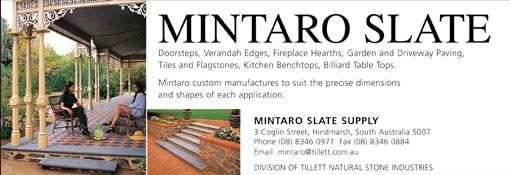
PP 536155/0036
ISSN 0815-7871
FRONT COVER:
PRESIDENT
Ms Deborah Morgan
VICE PRESIDENT
Mr George Hobbs
COUNCILLORS
Mr Graham Hancock
Mr James Harvey
Mr Eric Heapy
Ms Gabrielle Iwanow
Mr Steve Larkins OAM
Mr Paul Leadbeter
Mrs Caren Martin
Ms Millie Nicholls
Dr Nigel Ridgway
Ms Di Wilkins
NTSA STATE OFFICE STAFF
Dr Darren Peacock Chief Executive Officer
Helen Cartmel
Executive Administrator
Patrick Bugeja
Director, Experiences and Engagement
Alison De Backer
Australian Artisan Trades Academy
Peter Fosdike
Conservation Manager, Silver to Sea Way
Catherine Gawrysiuk
Membership and Communications
Chris Grant
Natural Heritage Manager
Helen Lawry School and family programs
Courtney Pasfield Venue hire Co-ordinator
Allison Russell Director, Silver to Sea Way Project
Mario Russo
Asset Manager
Cheryl Williss Finance Manager
COUNCIL COMMITTEES
Audit, Finance and Governance
Cultural Heritage Advisory
Natural Heritage Advisory
NTSA LOCAL BRANCHES (44)
Ardrossan, Burnside, Coromandel Valley, Gawler, Port of Adelaide, Tea Tree Gully, Ceduna, Cleve, Koppio, Streaky Bay, Tumby Bay, Whyalla, Auburn, Burra, Clare, Jamestown, Port Pirie, Barmera, Overland Corner, Renmark, Waikerie, Beachport, Glencoe, Keith, Kingston SE, Millicent, Mount Gambier, Naracoorte, Penola, Robe, Goolwa, Hahndorf, Kingscote KI, Mount Barker, Penneshaw, Port Elliot, Strathalbyn, Victor Harbor, Willunga, Central Yorke Peninsula, Kadina, Minlaton, Moonta, Wallaroo.
Telephone (08) 8202 9200 or visit nationaltrust.org.au/sa for contact information.
PATRON IN CHIEF
His Excellency the Honourable Hieu Van Le AC
Governor of South Australia
The National Trust of South Australia acknowledges its partners and supporters.
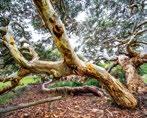
CIVIC PARTNERS
Adelaide City Council
CORPORATE PARTNERS
Beerenberg Farms
Bickfords
Coopers
Laucke Flour Mills
Piper Alderman
Stoneideas
Wines by Geoff Hardy
GOVERNMENT RELATIONSHIPS
Australian Government
Department of the Environment and Energy
National Library of Australia
South Australian Government
– Department of the Environment and Water
– SA Water
– History Trust of South Australia
Photo: South Australia’s 2021 Tree of the Year, a Dingley Dell gum at Port MacDonnell (photo by Ockert Le Roux).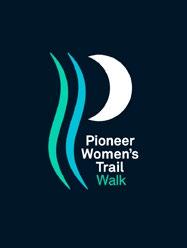
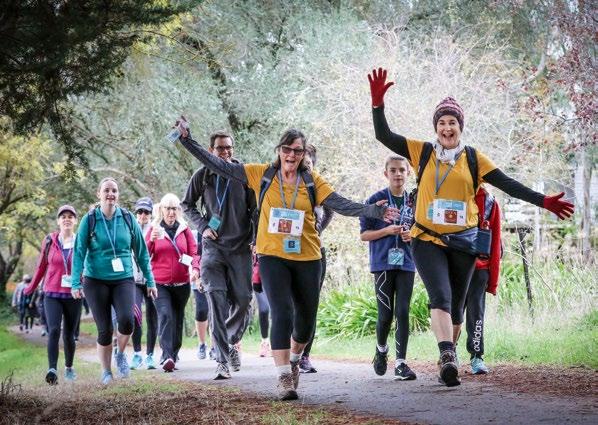

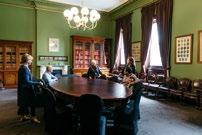
Go underground and journey through winding hallways and hidden chambers to discover the stories within and beneath one of Adelaide's oldest buildings. Meet some of the colorful characters who shaped South Australia in the building where history was made.


FOR MORE INFORMATION AND TO BOOK VISIT www.adelaidetours.net.au
PHONE: 8223 1234 GROUP
Adult $15, Concession $13, Member $10, Child $10